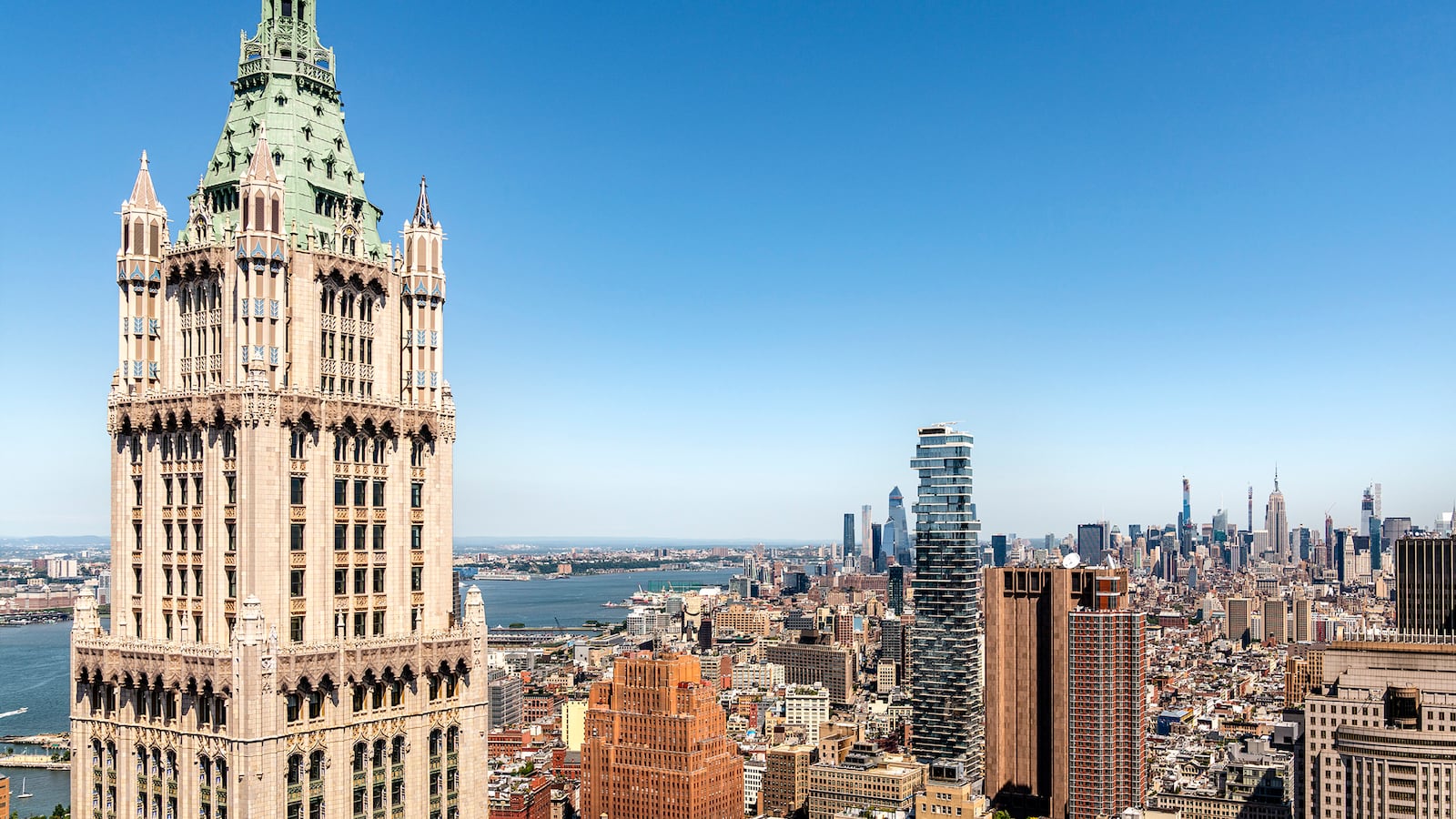An apartment is available in New York right now which is unlike any other property in the city, the nation, and likely the world. It fills the topmost floors of the Woolworth Building, that iconic lower Manhattan landmark which opened in 1913 as the headquarters of a sprawling discount retail chain. “The Pinnacle,” as it’s being marketed, is offered at $79 million, and includes four full floors within the tower’s pyramidal spire as well as a mezzanine and 360-degree open-air terrace at the building’s tip. Views spill outward endlessly in every direction from dozens of windows, filling the space with light. There is a silence there, so far above the city’s streets, and the imagination hums at the thought of calling such a place “home.”
There is one catch: The apartment is unfinished. It is floor after floor of cavernous possibility, tied together by a private elevator and a dozen bare steel beams. A dizzying spiral staircase leads from the upper living space to the cupola terrace and its breath-taking views. Any prospective buyer should come with both a vision and the funds to execute it.

The Woolworth Building opened in April of 1913, at a time when Americans were beginning to question their faith in unbridled progress and technology. Leading architects and politicians debated whether skyscrapers should be allowed in cities at all, calling them fire traps, eyesores, and a menace to public health. During the tower’s construction, the Triangle Shirtwaist Factory burned near Washington Square, killing 146. And the next year, the “unsinkable” RMS Titanic sank in the North Atlantic, carrying more than 1,500 passengers with it. New Yorkers ventured into the future with justified trepidation.
Despite this, the Woolworth Building climbed ever upward from lower Broadway. New Yorkers watched in awe as its steel skeleton rose above City Hall Park, 55 stories of steel anchored in Manhattan bedrock. Its design was meant to inspire confidence in modernity. Its facade, by far the most extensive use of terra cotta in architectural history, was lauded as both an artistic achievement and as completely fireproof. On completion, it was the tallest building in the world, a title it would hold until the 1930 topping-out of the Chrysler Building.
For its grand opening celebration, a black-tie banquet was held on the tower’s 27th floor, attended by 900 prominent guests. As they dined to the tunes of an orchestra, President Woodrow Wilson pressed a button at the White House which illuminated all of the tower’s 80,000 light bulbs at once. “A skyscraper built by the nickels of millions,” as The New York Times described it, the Woolworth Building was built to serve as the headquarters for the five-and-dime retail empire of Frank Winfield Woolworth. It heralded a new era of boldness and modernity both for New York and the nation as a whole.
Frank W. Woolworth was born in 1852, the son of a poor farmer in upstate New York. He left home at age 21 to apprentice as a shopkeeper and soon formed “the Woolworth Idea”: that it is human nature to want something for nothing. He believed that he could profit by selling a higher volume of goods at a lower price than other stores could make by selling a lower volume at higher prices. His idea caught on by the end of the 19th century and forever transformed the American retail landscape. By 1913, when the Woolworth Building opened in New York, there were nearly 600 Woolworth’s stores across the nation, drawing an estimated 2 million shoppers each day. Frank Woolworth, the son of a poor farmer, was able to pay for the tower in cash.
More than a century after its opening, the Woolworth Building remains one of New York’s most iconic landmarks. Nicknamed “the Cathedral of Commerce” for its gothic detailing, it stands 792 feet tall. It was the tallest building in the world for 17 years, only eclipsed in 1930 with the completion of the 1,046-foot Chrysler Building. The F.W. Woolworth Company kept its headquarters in the tower until 1997. That year, Woolworth’s was driven out of business by a new generation of discount retailers such as Wal-Mart, which emerged in the 20th century as big-box emulations of the Woolworth five-and-dime.
“To this day,” said TIME in 2013, “the Woolworth somehow manages to evince the gravitas of a church and the playfulness, and the irreverence, of a child’s fantasy castle.” That feeling of profound exuberance was fastidiously respected during the building’s recent transformation into a sky-high residential enclave. The residential lobby is tucked away at 2 Park Place, around the corner from the tower’s main Broadway entrance. It is entirely new-construction, boasting intricate bronze panels surmounted by the Gothic Woolworth “W” used by Cass Gilbert throughout the original parts of the building.
On a recent tour of the Woolworth Building’s apartments, I was accompanied by Kenneth Horn, founder and president of Alchemy Properties (the project’s developer) and Stan Ponte, sales director and senior global real estate advisor for Sotheby’s International Realty. They noted the care taken, the expense required, and the countless difficulties encountered while transforming century-old office space into million-dollar homes.
The lobby is small but lush, with gleaming marble floors, and its ceiling features nine original plaster panels from Frank Woolworth’s office. We took an elevator which, like the lobby’s entryway, features the Gothic Woolworth “W,” and we descended to the basement. Here, tenants have access to a number of amenities, including individual locking wine closets in a room chilled to 54F and a marble-lined swimming pool which is original to the building’s 1913 opening and was used by Mr. Woolworth himself. It all feels quiet and unpretentiously exclusive, like a luxe clubhouse or boutique hotel. There are, after all, just 33 apartments in the building, with prices starting near $6 million.

Building such luxury into the basement of an office building was no small feat. When work began, the lights didn’t work and the pool hadn’t been used in half a century. It was pitch black and covered in decades of dust and debris. Upstairs, rooftop air conditioning units blocked views, and many rooms lacked windows altogether. Literal tons of old drywall, plaster, and terracotta had to be chiseled away before construction could begin. Outside, Alchemy Properties invested $22 million into restoring the tower’s terracotta cladding. All that work, from demolition to installation and furnishing, had to be handled by two interior passenger elevators so as to not disturb the commercial trunk of the tower’s lower floors.
Inside, the residences were outfitted with exquisite finishes designed by Thierry Despont, who is perhaps better known for his restoration work on the Ritz Paris and Carlyle Hotels, as well as the Statue of Liberty. The residential portion of the Woolworth Building begins on the 29th floor, where two “Pavilion” residences feature double-height living rooms and terraces which are larger than most whole apartments. We first visited Pavilion A, which spans more than 6,000 square feet not including its 2,770 square foot terrace. It is offered at just under $26 million and is, aside from the Pinnacle unit, the last unsold apartment in the tower. (A third unit is in contract as of this writing.) It is currently staged for buyers, furnished in neutral tones with Baccarat chandeliers sparkling in every room.
Most other new luxury buildings feature floor-to-ceiling walls of glass, selling the endless views as part of the appeal. The Woolworth, far from lacking such views, frames them through windows which are, more often than not, original to Cass Gilbert’s design. Pointed Gothic dormers harmonize with an impressive array of newly-cut picture windows and skylights, all of which were approved by the city’s Landmarks Preservation Commission before construction. The result is a more furtive approach to the spectacular vistas afforded by the tower’s height; the skyline shifts from room to room, complementing residents’ furniture, wallpaper, or artwork. A skylight above the kitchen in Pavilion A looks directly up at The Woolworth’s spire. “We want residents to know they’re somewhere special,” said Mr. Ponte.

My time at The Woolworth concluded with a visit to “The Pinnacle,” the penthouse complex which begins on the tower’s 50th floor. After touring the apartment’s many cavernous rooms, trying to imagine how it might look once someone finishes it, I climbed the spiral stairs to the cupola. I felt a genuine thrill in stepping out onto the narrow, octagonal terrace, with all of New York twinkling beneath me. A century ago, Frank Woolworth likely stood there, as awed by the view as I was. His awe must’ve been bolstered by the knowledge that he owned the wooden planks beneath his feet, and that this view was the result of his life’s work. Now, some other New Yorker has the opportunity to feel that same sense of ownership, standing atop the city and feeling as awed and inspired by it tomorrow as a century ago.

